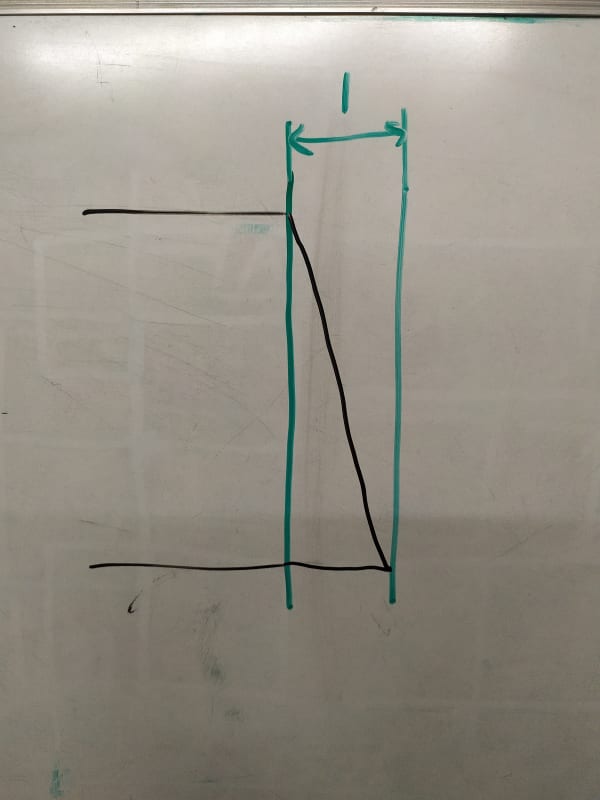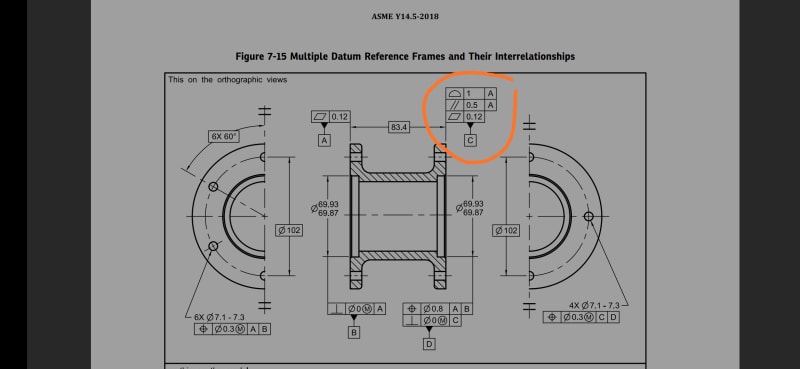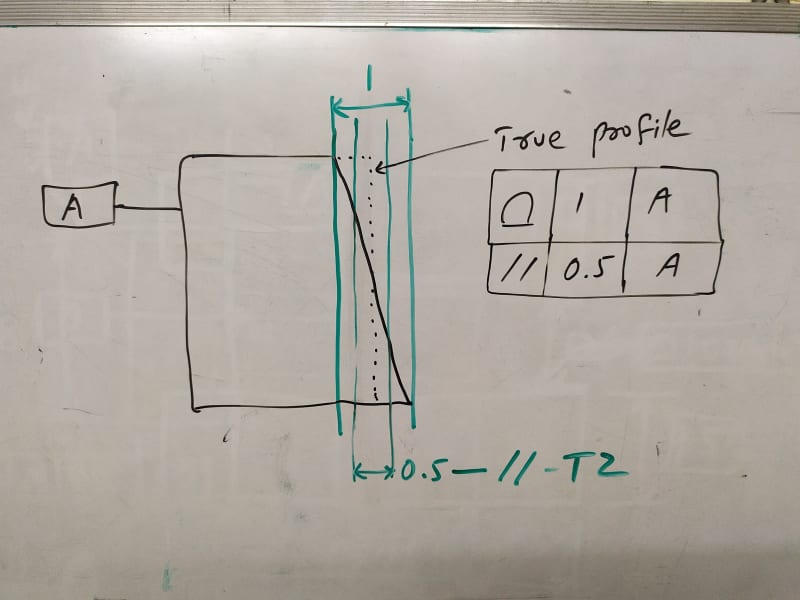Navigation
Install the app
How to install the app on iOS
Follow along with the video below to see how to install our site as a web app on your home screen.
Note: This feature may not be available in some browsers.
More options
Style variation
-
Congratulations TugboatEng on being selected by the Eng-Tips community for having the most helpful posts in the forums last week. Way to Go!
You are using an out of date browser. It may not display this or other websites correctly.
You should upgrade or use an alternative browser.
You should upgrade or use an alternative browser.
Location and orientation 2 1
- Thread starter Sa-Ro
- Start date
- Status
- Not open for further replies.
- Thread starter
- #3
Profile controlled to 1 wrt A. Tolerance zone is constrained in basic location AND orientation.
Parallelism controlled to 0.5 wrt A. Tolerance zone is constrained in basic orientation only.
Flatness controlled to 0.12 - no datum features are involved, so tolerance zone is constrained in NEITHER orientation nor location.
Ultimately form is held to within 0.12 due to the flatness tolerance, however the other two tolerances must also be satisfied which limits orientation and location variation relative to A.
Parallelism controlled to 0.5 wrt A. Tolerance zone is constrained in basic orientation only.
Flatness controlled to 0.12 - no datum features are involved, so tolerance zone is constrained in NEITHER orientation nor location.
Ultimately form is held to within 0.12 due to the flatness tolerance, however the other two tolerances must also be satisfied which limits orientation and location variation relative to A.
- Thread starter
- #5
Hence, When location and orientation tolerances are provided for same feature, location tolerance will control the orientation.
Consider this feature is produced within location.
Orientation for profile as below:

Now without considering the location, how this feature can be parallel within 0.5 wrt datum A?
Consider this feature is produced within location.
Orientation for profile as below:

Now without considering the location, how this feature can be parallel within 0.5 wrt datum A?
- Thread starter
- #6
-
1
- #7
When location and orientation tolerances are provided for same feature, location tolerance will not control the orientation.
As a genuine suggestion, you may want to take 3DDave's advice and review the definitions for the different tolerances. Profile, depending on the DRF specified can control all aspects of form, size, location, and orientation. Parallelism controls form and orientation. Flatness controls form. Specifying these on top of each other does not change these definitions or somehow override ones constraint of location or orientation.
For the flat planar feature shown, the shape of the profile, parallelism, and flatness tolerance zones are two parallel planes of widths 1, 0.5, and 0.12 respectively. The profile tolerance is the largest and is fixed in location and orientation. The parallelism tolerance is the next largest of 0.5 and can float in location within the 1 profile tolerance while remaining fixed in orientation. The 0.12 flatness tolerance is constrained in neither location or orientation and can float within the 0.5 parallelism tolerance which can in turn float within the 1 profile tolerance. All must be satisfied.
Now without considering the location, how this feature can be parallel within 0.5 wrt datum A?
Again, all the tolerance zones must be satisfied. You cannot ignore the location constraint provided by the profile tolerance, nor can you ignore the orientation constraint provided by the parallelism tolerance. In your latest figure (9 Jul 20 00:53) that feature would NOT pass inspection as it does not satisfy the 0.5 parallelism tolerance - the feature must be within two parallel planes 0.5 apart basically oriented to A. As noted before that 0.5 wide parallelism tolerance zone may float(translate) in a direction normal to A (left or right in your figure) as long as it stays basically oriented to A and within the profile zone.
- Thread starter
- #8
Sa-Ro,
The composite FCF applies three controls on the feature, increasing in precision. You have a fairly sloppy profile tolerance. Back in the day, you should have specified the length as 83.5[±]0.5, instead. The designer wants it to be somewhat more accurately parallel to datum feature[ ]A, and they want it to be fairly flat.
--
JHG
The composite FCF applies three controls on the feature, increasing in precision. You have a fairly sloppy profile tolerance. Back in the day, you should have specified the length as 83.5[±]0.5, instead. The designer wants it to be somewhat more accurately parallel to datum feature[ ]A, and they want it to be fairly flat.
--
JHG
- Thread starter
- #11
Burunduk
Mechanical
- May 2, 2019
- 2,580
Sa-Ro,
Once you are sure you fully understand this combination of geometrical controls, the next thing you might want to look into is composite profile tolerance for a single feature. Look it up in your version of Y14.5 (2009 or 2018). What was described here by chez311 and pmarc can also apply for the following case:
A composite profile control applied to the same face (a single profile symbol in 3 segments feature control frame). The first segment specifies a 1mm tolerance zone with reference to A. The second segment specifies 0.5, also with reference to A. The last segment - 0.12 without a datum reference. The key here is to realize that where there is a composite tolerance, the basic dimensions that locate the feature (or features) relative to the datums are relevant only to the first segment.
Once you are sure you fully understand this combination of geometrical controls, the next thing you might want to look into is composite profile tolerance for a single feature. Look it up in your version of Y14.5 (2009 or 2018). What was described here by chez311 and pmarc can also apply for the following case:
A composite profile control applied to the same face (a single profile symbol in 3 segments feature control frame). The first segment specifies a 1mm tolerance zone with reference to A. The second segment specifies 0.5, also with reference to A. The last segment - 0.12 without a datum reference. The key here is to realize that where there is a composite tolerance, the basic dimensions that locate the feature (or features) relative to the datums are relevant only to the first segment.
Burunduk said:Once you are sure you fully understand this combination of geometrical controls, the next thing you might want to look into is composite profile tolerance for a single feature.
All,
May I ask a question: I know has been discussed before (maybe for 1994 / 2009 version of the ASME Y14.5 standard) but is it recommended/ allowed to use composite tolerance for a single feature as suggested by Burunduk?
Or maybe it is allowed but not a good practice?
What do you think? Pros/ cons of such of practice ?
I am thinking that the committee's intent was to reserve composite for multiple features not for a single feature.
Burunduk
Mechanical
- May 2, 2019
- 2,580
greenimi,
There is a separate section in Y14.5-2009 for composite profile applied on a single feature - see sub-paragraphs 8.6.1 and 8.6.1.1.
Considering the letter of the standard this can't be the case.
There is even a separate terminology for the segments of a composite profile tolerance that omits the "pattern" term when the composite tolerance applies to a single feature.
There is a separate section in Y14.5-2009 for composite profile applied on a single feature - see sub-paragraphs 8.6.1 and 8.6.1.1.
greenimi said:I am thinking that the committee's intent was to reserve composite for multiple features not for a single feature.
Considering the letter of the standard this can't be the case.
There is even a separate terminology for the segments of a composite profile tolerance that omits the "pattern" term when the composite tolerance applies to a single feature.
Burunduk
Mechanical
- May 2, 2019
- 2,580
greenimi, the specific feature controlled by profile in 8-19 is both a single feature (an irregular feature of size) and a collection of features grouped by the all-around symbol (those features construct the single feature). The paragraph that refers to this figure is titled "8.6.1.1 Explanation of Composite Profile Tolerance for a Single Feature", and the concept clearly applies to a single feature of any shape.
Burunduk
Mechanical
- May 2, 2019
- 2,580
3DDave, you are probably referring to my last comments in the related thread "Location and Orientation 1".
All around being applicable to anything but profile would not make sense.
Do you think, for example, that flatness all-around can be a useful control?
Or orientation control all-around? Applying an all-around symbol for orientation as a refinement of a profile or as a stand-alone control will make an orientation tolerance zone control the size of an irregular feature of size.
All around being applicable to anything but profile would not make sense.
Do you think, for example, that flatness all-around can be a useful control?
Or orientation control all-around? Applying an all-around symbol for orientation as a refinement of a profile or as a stand-alone control will make an orientation tolerance zone control the size of an irregular feature of size.
"All around" was stolen from the welding community. Angularity applied to each of the individual surfaces would make sense, but the committee didn't change the name to show it's not allowed. So a note would serve the purpose:
Each Surface The Noted Profile Tolerance Applies To Shall Have Angularity Controlled to The Same DRF the Noted Profile Tolerance Uses.
There is presently no interpretation of orientation refinement of any feature controlled by a profile geometric characteristic symbol except individual surfaces, so the current situation is an arbitrary limitation applied by the committee. Hence, they should name it according to that arbitrary limitation.
Each Surface The Noted Profile Tolerance Applies To Shall Have Angularity Controlled to The Same DRF the Noted Profile Tolerance Uses.
There is presently no interpretation of orientation refinement of any feature controlled by a profile geometric characteristic symbol except individual surfaces, so the current situation is an arbitrary limitation applied by the committee. Hence, they should name it according to that arbitrary limitation.
pmarc
Mechanical
- Sep 2, 2008
- 3,248
greenimi said:May I ask a question: I know has been discussed before (maybe for 1994 / 2009 version of the ASME Y14.5 standard) but is it recommended/ allowed to use composite tolerance for a single feature as suggested by Burunduk?
Or maybe it is allowed but not a good practice?
What do you think? Pros/ cons of such of practice ?
I am thinking that the committee's intent was to reserve composite for multiple features not for a single feature.
I am with Burunduk that there is nothing wrong with applying composite profile to a single surface. In this particular case (flat surface application) the same requirement can be expressed with profile/parallelism/flatness combination so one might argue that the latter is much more straightforward choice.
But what if the toleranced surface was an arc or something?
- Status
- Not open for further replies.
Similar threads
- Locked
- Question
- Replies
- 6
- Views
- 881
- Locked
- Question
- Replies
- 38
- Views
- 2K
- Question
- Replies
- 6
- Views
- 10K
- Locked
- Question
- Replies
- 19
- Views
- 989
- Question
- Replies
- 9
- Views
- 14K



